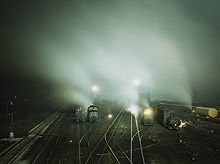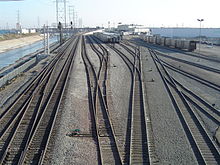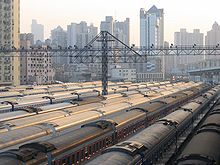- Rail yard
-
 Night view of part of Atchison, Topeka and Santa Fe Railway yard at Kansas City, Kansas. March 1943.
Night view of part of Atchison, Topeka and Santa Fe Railway yard at Kansas City, Kansas. March 1943.
A rail yard, or railroad yard, is a complex series of railroad tracks for storing, sorting, or loading/unloading, railroad cars and/or locomotives. Railroad yards have many tracks in parallel for keeping rolling stock stored off the mainline, so that they do not obstruct the flow of traffic. Railroad cars are moved around by specially designed yard switchers, a type of locomotive. Cars in a railroad yard may be sorted by numerous categories, including railroad company, loaded or unloaded, destination, car type, or whether they need repairs. Railroad yards are normally built where there is a need to store cars while they are not being loaded or unloaded, or are waiting to be assembled into trains. Large yards may have a tower to control operations.[1]:46
Many railway yards are located at strategic points on a main line. Main line yards are often composed of an Up yard and a Down yard, linked to the associated railroad direction. There are different types of yards, and different parts within a yard, depending on how they are built.
Contents
Freight yards
For freight cars, the overall yard layout is typically designed around a principal switching (US term) or shunting (UK) technique:
- A hump yard has a constructed hill, over which freight cars are shoved by yard locomotives, and then gravity is used to propel the cars to various sorting tracks;
- A gravity yard is built on a natural slope and relies less on locomotives;
- A flat yard has no hump, and relies on locomotives for all car movements.
Hump yard and gravity yard tracks are equipped with mechanical retarders which control the speed of the cars as they roll downhill to their destination tracks.
A large freight yard complex may include the following components:
- Receiving yard, also called an arrival yard, where locomotives are detached from freight cars, cars are inspected for mechanical problems, and sent to a classification yard;
- Classification yard (US and by Canadian National Railway in Canada) or Marshalling yard (UK and Canadian Pacific Railway in Canada) where cars are sorted for various destinations and assembled into blocks (this is also known as sorting yard colloquially);
- Departure yard where car blocks are assembled into trains;
- Car repair yard for freight cars;
- Engine house (in some yards, a roundhouse) to fuel and service locomotives.[1]:58
Unit trains, which carry a block of cars all of the same origin and destination, do not get sorted in a classification yard, but may stop in a freight yard for inspection, engine servicing, and/or crew changes.[1]:52
Freight yards may have multiple industries adjacent to them where railroad cars are loaded or unloaded and then stored before they move on to their new destination.
Major freight yards in the U.S. include the Bailey Yard in North Platte, Nebraska, operated by Union Pacific Railroad, and the Corwith Yards (Corwith Intermodal Facility) in Chicago, operated by BNSF Railway.
Major U.K. freight (goods) yards include those in Crewe, Reading and Bescot, near Walsall; which are operated by EWS and Freightliner.
Coach yards
Coach yards are used for sorting, storing and repairing passenger cars. These yards are located in metropolitan areas near large stations or terminals. An example of a major U.S. coach yard is Sunnyside Yard in New York City, operated by Amtrak. Those that are principally used for storage, such as the West Side Yard, are called "layup yards". [2] or "stabling yards".
Major U.K. coach stabling yards include those in Crewe and Longsight, Manchester; which are operated by various regional train companies.
See also
- Anchor portal
- Classification yard
- List of rail yards
- List of railway roundhouses
- Rail transport operations
References
- ^ a b c Edwin Kraft, "The Yard: Railroading's Hidden Half." Trains Magazine, Vol. 62, No. 6, June 2002.
- ^ Chicago-l.org
Further reading
- Armstrong, John H. (1998). The Railroad: What It Is, What It Does (4th ed.). Omaha, NE: Simmons-Boardman. ISBN 9780911382044.
- Farrington, Jr., S. Kip (1958). Railroads of the Hour. New York: Coward-McCann.
Railway track layouts Running lines Rail sidings Junctions Stations Side platform • Island platform • Bay platform • Split platform • Terminal station • Balloon loop • Spanish solution • Cross-platform interchange • Interchange stationHillclimbing Railway infrastructure Permanent way Permanent way (history) • Permanent way (current) • Railroad tie/Sleeper • Rail fastening system • Track ballast • Rail profile • Fishplate • Breather switch • Datenail • Axe ties • Ladder track • Baulk road • Cant • Minimum radius • Track transition curveTrackwork and track structures Junction • Wye • Railroad switch • Gauntlet track • Railway electrification system • Overhead lines • Track gauge • Railway turntable • Water crane • Track pan • Rail track • Tramway track • Classification yard • Rail yard • Siding • Passing loop • Balloon loopSignalling and safety Railway signalling • Signalling control • Railway signal • Interlocking • Level crossing • Buffer stop • Catch points • Loading gauge • Structure gauge • Block postBuildings Categories:- Railway track layouts
- Rail yards
- Rail transport operations
Wikimedia Foundation. 2010.



